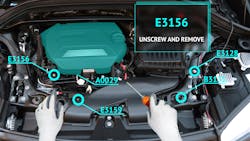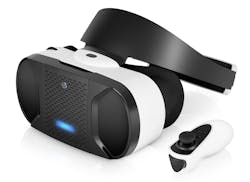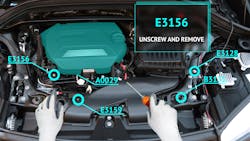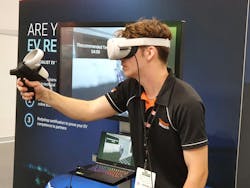Though it’s only been around in its modern form for a little over a decade, virtual reality can trace its history back well over a hundred years.
Research conducted by English scientist Charles Wheatstone in the 1830s showed that humans could process two copies of the same image placed right next to each other as having depth, leading to the eventual development of early stereoscopes.
Tech companies began to develop some of the earliest iterations of modern VR technology in the 1960s, and video game companies such as Nintendo and Sega began experimenting with making that technology portable in the 1990s through the ill-fated Virtual Boy and Sega VR headset consoles.
Though none of those devices develop a mainstream following, they laid the groundwork for where virtual reality technology is today. Mike Mertes, learning innovation and technology manager for I-CAR, says that the technology is ripe with applications for the auto repair industry and could help shape the technician training field rapidly over the next decade.
“In the last three years, especially as the equipment becomes cheaper, it's far more approachable,” Mertes says. “The technology to develop the training scenarios used techs is becoming a lot easier to use, too.”
As the collision repair industry continues to develop content for virtual reality headsets, training and collaboration with other institutions will only continue to become easier.
Applications for VR in Collision Repair
Virtual reality, like any other brand-new technology that explodes into the public eye, suffered from becoming a fad before people really knew what to do with it. Mertes says this why the collision repair industry is only just now starting to really latch on to the technology despite its prevalence throughout the 2010s.
“I think everyone got really excited with the technology … but had no real plan. That happened a lot throughout the industry, and it set a lot of people off from it because they had all the hardware, but they didn't have a great concept of how to use it or relevant experience.”
Despite the initial industry-wide skepticism, virtual reality technology lends itself quite well to training. Most training developers such as I-CAR are using the technology to develop guide-based step-by-step training simulations that allow trainees to practice a repair procedure under a simulated car hood before taking those lessons and trying to apply them under an actual hood.
Mertes says techs can greatly reduce the amount of time it takes to learn how to properly diagnose and repair electric vehicles through the use of VR. Having a simulation allows a trainee to interact with an electric vehicle in real time without the real-world risks, while at the same time having access to repair procedures, PPE guides and other necessary documents all at their fingertips.
“That's one of the biggest advantages of VR. You can instill confidence with that education, especially when you're dealing with something that, if you were working on a live vehicle that had voltage running through it, could electrocute you and end your life,” Mertes says. “Talk about something you wouldn't want to work on in real life without some sort of training.”
And as the technology becomes more globally available and easily accessible, more developers will build programs that will help train techs on very specific jobs throughout an entire body shop. Program developer SprayVerse has created what its website describes as “the most advanced virtual spray-painting training solution” and is used by training institutions, OEMs and paint companies.
Mertes says it’s hard to gauge exactly how many shops, institutions and other stakeholders in the collision industry are using VR, but looking at other industries shows just how effective VR training can be if utilized properly.
“From a worldwide perspective, companies such as Boeing and United are using the technology, and it's improved their training tenfold,” he says. “That experience really helps get those fundamental skills established so you can help take that to a real-world experience.”
The possibilities for integrated repair programs aren’t just limited to virtual reality, either. Augmented reality, which is takes the user’s environment in through a camera and enhances it with graphics and other visual elements, presents another opportunity for the repair industry.
Through AR technology, it would be possible to develop a program that allows a tech to put on a headset, and instead of just seeing the actual vehicle, they would have notifications, procedures and other guides directly in their heads-up display.
“Maybe it pulls up recall information,” Mertes says. “Maybe there's a particular process that you're working on and you need to know where those components are located, and it shows you exactly where they are.”
Additionally, AR headsets can act essentially as mounted webcams that allow other people to see what the user is seeing. Mertes says those remote capabilities would allow a tech who is stuck during a repair or has a question come up to virtually bring in an outside pro to look at the vehicle and guide the user through the correct procedure in real time. That, as a result, saves a lot of time wasted waiting and the cost of bringing in that outside source.
"Rather than having to fly someone in or get your pro service tech, you can actually call them right through the headset and they can see through your eyes what you're trying to do,” Mertes says. “They can see how far you are in the process. If they see something you're missing, they can circle it, highlight it, and you can see those marks through your headset.”
Industry Adoption of VR
Though there are examples of real-world applications of VR training, the technology is still in the early-adoption phase for the collision repair industry. Mertes says its crucial for shops to talk to their technology vendors to determine if VR makes sense for their operation and, if so, how to apply it.
“The work is still going in to see what makes the most sense for the industry,” Mertes says. “The best place to start would be working with your technology vendors to figure out what you're trying to
accomplish. There are a lot of different headsets out there, and the last thing we want is for a shop to invest in something without due research.”
Virtual and augmented reality technology provides some exciting opportunities for collision repair, and Mertes says it will only continue to get easier for shops to start experimenting with different headsets and training options.
“I think total industry adoption will probably be within the next two to five years,” he says. “The seeds have really just started to be planted, and you're starting to see a little bit of growth, but there's still a while to go.”
About the Author

Noah Brown
Noah Brown is a freelance writer and former senior digital editor for 10 Missions Media, where he facilitated multimedia production several of the company's publications.



